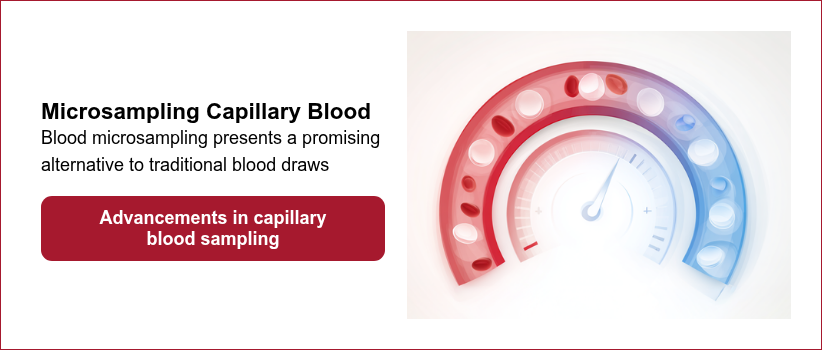Share this
capillary blood collection: advantages and disadvantages
by Neoteryx Microsampling on Jul 13, 2017 7:27:00 AM

Capillary blood collection utilizing methods such as finger-sticks, heel-sticks, or other small punctures offers an alternative to traditional venous blood draws.
Once primarily used for newborn screenings, its applications have expanded significantly and are now utilized in various research and clinical settings. Below, we explore how capillary sampling works, its advantages and disadvantages, and important factors to consider for ensuring accuracy and usability.
How Capillary Blood Collection Works
Capillary blood is collected by making a small puncture in the fingertip for adults or the heel for infants and young children using a lancet. After the puncture, blood droplets are collected directly onto filter paper, in small glass capillary tubes, or using absorbent tips from microsampling devices.
These samples can then be transferred for testing or analyzed using dried blood spot methods, microsampling devices, or glucose strips, depending on the type of test being conducted.
Key Advantages of Capillary Blood Collection
- Minimal Blood Requirement: This reduces complications linked with significant blood loss, especially in vulnerable patients. For instance, ICU patients undergoing venous blood sampling can lose up to 2% of their total blood volume daily.
- Ease of Collection: The finger-stick capillary blood collection procedure is less intrusive than traditional venous blood draws and is nearly painless. With traditional blood draws, locating a vein in the arm, especially in children or the elderly, can be a challenging and distressing task.
- Home Collection: With adequate training, individuals can use a finger-stick method to perform capillary blood collections at home. This method is popular among diabetics for routine blood sugar checks, and is becoming more widely accepted by various research and healthcare industries.
- Varied Collection Sites: Using different fingertips or even other sampling sites, such as the heel of the hand or the upper arm, can minimize the risk of scarring and discomfort.
- Growing in Popularity: More labs and research facilities are recognizing and implementing capillary blood collection methods using microsampling devices.
Disadvantages of Capillary Blood Collection
- Limitations for Certain Tests: Not all laboratory tests are suitable for capillary samples; some assays, particularly those sensitive to collection volume or processing, may yield less reliable results.
- Risk of Cell Rupture (Hemolysis): Mishandling of samples can lead to cell rupture, which may distort test results.
- Potential Complications: Some patients may experience complications such as bleeding, infection, or light-headedness.
- Scarring from Repeated Lancing: Repeated use of the same site for blood collection can result in scarring.
- Complications in Infants: Small blood collection sites in infants can occasionally lead to mild complications like calcified nodules, though these typically resolve on their own.
Accuracy and Interpretation: Capillary vs. Plasma Samples
In general, the differences between capillary blood and plasma are minimal for many tests. However, readings for hemoglobin, hematocrit, and platelet counts may vary between the two sample types. For example, capillary and venous glucose measurements can show slight discrepancies when taken simultaneously. Consequently, researchers and clinicians must consider what kind of capillary blood collection procedure when interpreting results.

Share this
- Microsampling (206)
- Research, Remote Research (119)
- Venipuncture Alternative (105)
- Clinical Trials, Clinical Research (83)
- Mitra® Device (73)
- Therapeutic Drug Monitoring, TDM (51)
- Dried Blood Spot, DBS (39)
- Biomonitoring, Health, Wellness (30)
- Infectious Disease, Vaccines, COVID-19 (24)
- Blood Microsampling, Serology (23)
- Omics, Multi-Omics (21)
- Decentralized Clinical Trial (DCT) (20)
- Specimen Collection (18)
- Toxicology, Doping, Drug/Alcohol Monitoring, PEth (17)
- Skin Microsampling, Microbiopsy (14)
- hemaPEN® Device (13)
- Preclinical Research, Animal Studies (12)
- Pharmaceuticals, Drug Development (9)
- Harpera Device (7)
- Industry News, Microsampling News (5)
- Antibodies, MAbs (3)
- Company Press Release, Product Press Release (3)
- Environmental Toxins, Exposures (1)
- July 2025 (1)
- May 2025 (1)
- April 2025 (2)
- December 2024 (2)
- November 2024 (1)
- October 2024 (3)
- September 2024 (1)
- June 2024 (1)
- May 2024 (1)
- April 2024 (4)
- March 2024 (1)
- February 2024 (2)
- January 2024 (4)
- December 2023 (3)
- November 2023 (3)
- October 2023 (3)
- September 2023 (3)
- July 2023 (3)
- June 2023 (2)
- April 2023 (2)
- March 2023 (2)
- February 2023 (2)
- January 2023 (3)
- December 2022 (2)
- November 2022 (3)
- October 2022 (4)
- September 2022 (3)
- August 2022 (5)
- July 2022 (2)
- June 2022 (2)
- May 2022 (4)
- April 2022 (3)
- March 2022 (3)
- February 2022 (4)
- January 2022 (5)
- December 2021 (3)
- November 2021 (5)
- October 2021 (3)
- September 2021 (3)
- August 2021 (4)
- July 2021 (4)
- June 2021 (4)
- May 2021 (4)
- April 2021 (3)
- March 2021 (5)
- February 2021 (4)
- January 2021 (4)
- December 2020 (3)
- November 2020 (5)
- October 2020 (4)
- September 2020 (3)
- August 2020 (3)
- July 2020 (6)
- June 2020 (4)
- May 2020 (4)
- April 2020 (3)
- March 2020 (6)
- February 2020 (3)
- January 2020 (4)
- December 2019 (5)
- November 2019 (4)
- October 2019 (2)
- September 2019 (4)
- August 2019 (4)
- July 2019 (3)
- June 2019 (7)
- May 2019 (6)
- April 2019 (5)
- March 2019 (6)
- February 2019 (5)
- January 2019 (8)
- December 2018 (3)
- November 2018 (4)
- October 2018 (7)
- September 2018 (6)
- August 2018 (5)
- July 2018 (8)
- June 2018 (6)
- May 2018 (5)
- April 2018 (6)
- March 2018 (4)
- February 2018 (6)
- January 2018 (4)
- December 2017 (2)
- November 2017 (3)
- October 2017 (2)
- September 2017 (4)
- August 2017 (2)
- July 2017 (4)
- June 2017 (5)
- May 2017 (6)
- April 2017 (6)
- March 2017 (5)
- February 2017 (4)
- January 2017 (1)
- July 2016 (3)
- May 2016 (1)
- April 2016 (2)


Comments (5)